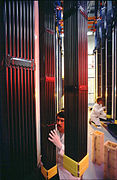Nuclear fuel
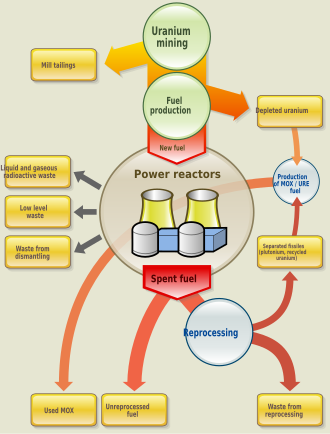
Nuclear fuel is material used in nuclear power stations to produce heat to power turbines. Heat is created when nuclear fuel undergoes nuclear fission.
Most nuclear fuels contain heavy
The processes involved in mining, refining, purifying, using, and disposing of nuclear fuel are collectively known as the nuclear fuel cycle.
Not all types of nuclear fuels create power from nuclear fission; plutonium-238 and some other isotopes are used to produce small amounts of nuclear power by radioactive decay in radioisotope thermoelectric generators and other types of atomic batteries.
Nuclear fuel has the highest energy density of all practical fuel sources.
Oxide fuel
For fission reactors, the fuel (typically based on uranium) is usually based on the metal oxide; the oxides are used rather than the metals themselves because the oxide melting point is much higher than that of the metal and because it cannot burn, being already in the oxidized state.
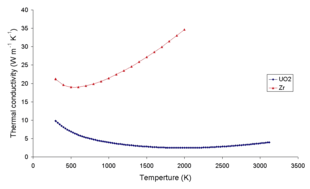
Uranium dioxide
Uranium dioxide is a black semiconducting solid. It can be made by heating uranyl nitrate to form UO
2.
- UO2(NO3)2 · 6 H2O → UO2 + 2 NO2 + ½ O2 + 6 H2O (g)
This is then converted by heating with hydrogen to form UO2. It can be made from enriched uranium hexafluoride by reacting with ammonia to form a solid called ammonium diuranate, (NH4)2U2O7. This is then heated (calcined) to form UO
3 and U3O8 which is then converted by heating with hydrogen or ammonia to form UO2.[1]
The UO2 is mixed with an organic binder and pressed into pellets, these pellets are then fired at a much higher temperature (in H2/Ar) to sinter the solid. The aim is to form a dense solid which has few pores.
The thermal conductivity of uranium dioxide is very low compared with that of zirconium metal, and it goes down as the temperature goes up.
Corrosion of uranium dioxide in water is controlled by similar
While exposed to the neutron flux during normal operation in the core environment a small percentage of the 238U in the fuel absorbs excess neutrons and is transmuted into 239U. 239U rapidly decays into 239Np which in turn rapidly decays into 239Pu. The small percentage of 239Pu has a higher neutron cross section than 235U. As the 239Pu accumulates the chain reaction shifts from pure 235U at initiation of the fuel use to a ratio of about 70% 235U and 30% 239Pu at the end of the 18 to 24 month fuel exposure period.[2]
MOX
Mixed oxide, or MOX fuel, is a blend of
Some concern has been expressed that used MOX cores will introduce new disposal challenges, though MOX is itself a means to dispose of surplus plutonium by transmutation.
Reprocessing of commercial nuclear fuel to make MOX was done in the
The Global Nuclear Energy Partnership, was a U.S. proposal in the George W. Bush administration to form an international partnership to see spent nuclear fuel reprocessed in a way that renders the plutonium in it usable for nuclear fuel but not for nuclear weapons. Reprocessing of spent commercial-reactor nuclear fuel has not been permitted in the United States due to nonproliferation considerations. All of the other reprocessing nations have long had nuclear weapons from military-focused "research"-reactor fuels except for Japan. Normally, with the fuel being changed every three years or so, about half of the 239Pu is 'burned' in the reactor, providing about one third of the total energy. It behaves like 235U and its fission releases a similar amount of energy. The higher the burn-up, the more plutonium in the spent fuel, but the lower the fraction of fissile plutonium. Typically about one percent of the used fuel discharged from a reactor is plutonium, and some two thirds of this is fissile (c. 50% 239Pu, 15% 241Pu). Worldwide, some 70 tonnes of plutonium contained in used fuel is removed when refueling reactors each year.[citation needed]
Metal fuel
Metal fuels have the advantage of a much higher heat conductivity than oxide fuels but cannot survive equally high temperatures. Metal fuels have a long history of use, stretching from the
TRIGA fuel
Actinide fuel
In a
Molten plutonium
Molten plutonium, alloyed with other metals to lower its melting point and encapsulated in tantalum,[4] was tested in two experimental reactors, LAMPRE I and LAMPRE II, at Los Alamos National Laboratory in the 1960s. "LAMPRE experienced three separate fuel failures during operation."[5]
Non-oxide ceramic fuels
Ceramic fuels other than oxides have the advantage of high heat conductivities and melting points, but they are more prone to swelling than oxide fuels and are not understood as well.
Uranium nitride
This is often the fuel of choice for reactor designs that
Uranium carbide
Much of what is known about uranium carbide is in the form of pin-type fuel elements for
The high thermal conductivity and high melting point makes uranium carbide an attractive fuel. In addition, because of the absence of oxygen in this fuel (during the course of irradiation, excess gas pressure can build from the formation of O2 or other gases) as well as the ability to complement a ceramic coating (a ceramic-ceramic interface has structural and chemical advantages), uranium carbide could be the ideal fuel candidate for certain
C will undergo neutron capture to produce stable 13
C as well as radioactive 14
C. Unlike the 14
C produced by using Uranium nitrate, the 14
C will make up only a small isotopic impurity in the overall carbon content and thus make the entirety of the carbon content unsuitable for non-nuclear uses but the 14
C concentration will be too low for use in nuclear batteries without enrichment. Nuclear graphite
Liquid fuels
Liquid fuels are liquids containing dissolved nuclear fuel and have been shown to offer numerous operational advantages compared to traditional solid fuel approaches.[6]
Liquid-fuel reactors offer significant safety advantages due to their inherently stable "self-adjusting" reactor dynamics. This provides two major benefits: virtually eliminating the possibility of a runaway reactor meltdown, and providing an automatic load-following capability which is well suited to electricity generation and high-temperature industrial heat applications.
Another major advantage of some liquid core designs is their ability to be drained rapidly into a passively safe dump-tank. This advantage was conclusively demonstrated repeatedly as part of a weekly shutdown procedure during the highly successful 4 year
Another huge advantage of the liquid core is its ability to release xenon gas, which normally acts as a neutron absorber (
Cs, which behaves similar to other alkali metals
Molten salts
Molten salt fuels are mixtures of actinide salts (e.g. thorium/uranium fluoride/chloride) with other salts, used in liquid form above their typical melting points of several hundred degrees C. In some
Molten salt fuels were used in the LFTR known as the Molten Salt Reactor Experiment, as well as other liquid core reactor experiments. The liquid fuel for the molten salt reactor was a mixture of lithium, beryllium, thorium and uranium fluorides: LiF-BeF2-ThF4-UF4 (72-16-12-0.4 mol%). It had a peak operating temperature of 705 °C in the experiment, but could have operated at much higher temperatures since the boiling point of the molten salt was in excess of 1400 °C.
Aqueous solutions of uranyl salts
The
Liquid metals or alloys
The
Common physical forms of nuclear fuel
Uranium dioxide (UO2) powder is compacted to cylindrical pellets and sintered at high temperatures to produce ceramic nuclear fuel pellets with a high density and well defined physical properties and chemical composition. A grinding process is used to achieve a uniform cylindrical geometry with narrow tolerances. Such fuel pellets are then stacked and filled into the metallic tubes. The metal used for the tubes depends on the design of the reactor. Stainless steel was used in the past, but most reactors now use a
Cladding is the outer layer of the fuel rods, standing between the coolant and the nuclear fuel. It is made of a
-
Nuclear Regulatory Commission (NRC) photo of unirradiated (fresh) fuel pellets.
-
NRC photo of fresh fuel pellets ready for assembly.
-
NRC photo of fresh fuel assemblies being inspected.

Pressurized water reactor fuel
Boiling water reactor fuel
In boiling water reactors (BWR), the fuel is similar to PWR fuel except that the bundles are "canned". That is, there is a thin tube surrounding each bundle. This is primarily done to prevent local density variations from affecting neutronics and thermal hydraulics of the reactor core. In modern BWR fuel bundles, there are either 91, 92, or 96 fuel rods per assembly depending on the manufacturer. A range between 368 assemblies for the smallest and 800 assemblies for the largest BWR in the U.S. form the reactor core. Each BWR fuel rod is backfilled with helium to a pressure of about 3 standard atmospheres (300 kPa).

Canada deuterium uranium fuel
U content about 0.1 percentage points
Less-common fuel forms
Various other nuclear fuel forms find use in specific applications, but lack the widespread use of those found in BWRs, PWRs, and CANDU power plants. Many of these fuel forms are only found in research reactors, or have military applications.

Magnox fuel
Magnox (magnesium non-oxidising) reactors are pressurised, carbon dioxide–cooled, graphite-moderated reactors using natural uranium (i.e. unenriched) as fuel and Magnox alloy as fuel cladding. Working pressure varies from 6.9 to 19.35 bars (100.1 to 280.6 psi) for the steel pressure vessels, and the two reinforced concrete designs operated at 24.8 and 27 bars (24.5 and 26.6 atm). Magnox alloy consists mainly of magnesium with small amounts of aluminium and other metals—used in cladding unenriched uranium metal fuel with a non-oxidising covering to contain fission products. This material has the advantage of a low neutron capture cross-section, but has two major disadvantages:
- It limits the maximum temperature, and hence the thermal efficiency, of the plant.
- It reacts with water, preventing long-term storage of spent fuel under water - such as in a spent fuel pool.
Magnox fuel incorporated cooling fins to provide maximum heat transfer despite low operating temperatures, making it expensive to produce. While the use of uranium metal rather than oxide made nuclear reprocessing more straightforward and therefore cheaper, the need to reprocess fuel a short time after removal from the reactor meant that the fission product hazard was severe. Expensive remote handling facilities were required to address this issue.
Tristuctural-isotropic fuel

Tristructural-isotropic (TRISO) fuel is a type of micro-particle fuel. A particle consists of a kernel of
TRISO fuel particles were originally developed in the United Kingdom as part of the Dragon reactor project. The inclusion of the SiC as diffusion barrier was first suggested by D. T. Livey.[9] The first nuclear reactor to use TRISO fuels was the Dragon reactor and the first powerplant was the THTR-300. Currently, TRISO fuel compacts are being used in some experimental reactors, such as the HTR-10 in China and the high-temperature engineering test reactor in Japan. In the United States, spherical fuel elements utilizing a TRISO particle with a UO2 and UC solid solution kernel are being used in the Xe-100, and Kairos Power is developing a 140 MWE nuclear reactor that uses TRISO.[10]
QUADRISO fuel
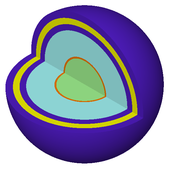
In QUADRISO particles a
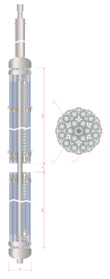
RBMK fuel
RBMK reactor fuel was used in Soviet-designed and built RBMK-type reactors. This is a low-enriched uranium oxide fuel. The fuel elements in an RBMK are 3 m long each, and two of these sit back-to-back on each fuel channel, pressure tube. Reprocessed uranium from Russian VVER reactor spent fuel is used to fabricate RBMK fuel. Following the Chernobyl accident, the enrichment of fuel was changed from 2.0% to 2.4%, to compensate for control rod modifications and the introduction of additional absorbers.
CerMet fuel
CerMet fuel consists of ceramic fuel particles (usually uranium oxide) embedded in a metal matrix. It is hypothesized[by whom?] that this type of fuel is what is used in United States Navy reactors. This fuel has high heat transport characteristics and can withstand a large amount of expansion.
Plate-type fuel
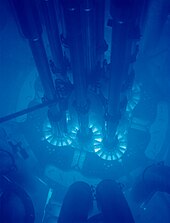
Plate-type fuel has fallen out of favor over the years. Plate-type fuel is commonly composed of enriched uranium sandwiched between metal cladding. Plate-type fuel is used in several research reactors where a high neutron flux is desired, for uses such as material irradiation studies or isotope production, without the high temperatures seen in ceramic, cylindrical fuel. It is currently used in the Advanced Test Reactor (ATR) at Idaho National Laboratory, and the nuclear research reactor at the University of Massachusetts Lowell Radiation Laboratory.[citation needed]
Sodium-bonded fuel
Sodium-bonded fuel consists of fuel that has liquid sodium in the gap between the fuel slug (or pellet) and the cladding. This fuel type is often used for sodium-cooled liquid metal fast reactors. It has been used in EBR-I, EBR-II, and the FFTF. The fuel slug may be metallic or ceramic. The sodium bonding is used to reduce the temperature of the fuel.
Accident tolerant fuels
Accident tolerant fuels (ATF) are a series of new nuclear fuel concepts, researched in order to improve fuel performance under accident conditions, such as
Neutronics analyses were performed for the application of the new fuel-cladding material systems for various types of ATF materials.[13]
The aim of the research is to develop nuclear fuels that can tolerate loss of active cooling for a considerably longer period than the existing fuel designs and prevent or delay the release of radionuclides during an accident.[14] This research is focused on reconsidering the design of fuel pellets and cladding,[15][16] as well as the interactions between the two.[17][13][18][19][20]
Spent nuclear fuel
Used nuclear fuel is a complex mixture of the
Oxide fuel under accident conditions
Two main modes of release exist, the fission products can be vaporised or small particles of the fuel can be dispersed.
Fuel behavior and post-irradiation examination
Post-Irradiation Examination (PIE) is the study of used nuclear materials such as nuclear fuel. It has several purposes. It is known that by examination of used fuel that the failure modes which occur during normal use (and the manner in which the fuel will behave during an accident) can be studied. In addition information is gained which enables the users of fuel to assure themselves of its quality and it also assists in the development of new fuels. After major accidents the core (or what is left of it) is normally subject to PIE to find out what happened. One site where PIE is done is the ITU which is the EU centre for the study of highly radioactive materials.
Materials in a high-radiation environment (such as a reactor) can undergo unique behaviors such as swelling[22] and non-thermal creep. If there are nuclear reactions within the material (such as what happens in the fuel), the stoichiometry will also change slowly over time. These behaviors can lead to new material properties, cracking, and fission gas release.
The
and radiation damage of the lattice. The low thermal conductivity can lead to overheating of the center part of the pellets during use. The porosity results in a decrease in both the thermal conductivity of the fuel and the swelling which occurs during use.According to the
The bulk density of the fuel can be related to the thermal conductivity.
Where ρ is the bulk density of the fuel and ρtd is the theoretical density of the uranium dioxide.
Then the thermal conductivity of the porous phase (Kf) is related to the conductivity of the perfect phase (Ko, no porosity) by the following equation. Note that s is a term for the shape factor of the holes.
- Kf = Ko(1 − p/1 + (s − 1)p)
Rather than
- λ = ρCpα
- λ thermal conductivity
- ρ density
- Cp heat capacity
- α thermal diffusivity
If t1/2 is defined as the time required for the non illuminated surface to experience half its final temperature rise then.
- α = 0.1388 L2/t1/2
- L is the thickness of the disc
For details see K. Shinzato and T. Baba (2001).[24]
Radioisotope decay fuels
Radioisotope battery
An
There are two main categories of atomic batteries: thermal and non-thermal. The non-thermal atomic batteries, which have many different designs, exploit charged
Radioisotope thermoelectric generator
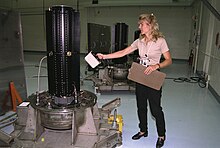
A
Po

Radioisotope heater unit (RHU)
A radioisotope heater unit (RHU) typically provides about 1 watt of heat each, derived from the decay of a few grams of plutonium-238. This heat is given off continuously for several decades.
Their function is to provide highly localised heating of sensitive equipment (such as electronics in outer space). The Cassini–Huygens orbiter to Saturn contains 82 of these units (in addition to its 3 main RTGs for power generation). The Huygens probe to Titan contains 35 devices.
Fusion fuels
Fusion fuels are fuels to use in hypothetical Fusion power reactors. They include deuterium (2H) and tritium (3H) as well as helium-3 (3He). Many other elements can be fused together, but the larger electrical charge of their nuclei means that much higher temperatures are required. Only the fusion of the lightest elements is seriously considered as a future energy source. Fusion of the lightest atom, 1H hydrogen, as is done in the Sun and other stars, has also not been considered practical on Earth. Although the energy density of fusion fuel is even higher than fission fuel, and fusion reactions sustained for a few minutes have been achieved, utilizing fusion fuel as a net energy source remains only a theoretical possibility.[25]
First-generation fusion fuel
Deuterium and tritium are both considered first-generation fusion fuels; they are the easiest to fuse, because the electrical charge on their nuclei is the lowest of all elements. The three most commonly cited nuclear reactions that could be used to generate energy are:
- 2H + 3H → n (14.07 MeV) + 4He (3.52 MeV)
- 2H + 2H → n (2.45 MeV) + 3He (0.82 MeV)
- 2H + 2H → p (3.02 MeV) + 3H (1.01 MeV)
Second-generation fusion fuel
Second-generation fuels require either higher confinement temperatures or longer confinement time than those required of first-generation fusion fuels, but generate fewer neutrons. Neutrons are an unwanted byproduct of fusion reactions in an energy generation context, because they are absorbed by the walls of a fusion chamber, making them radioactive. They cannot be confined by magnetic fields, because they are not electrically charged. This group consists of deuterium and helium-3. The products are all charged particles, but there may be significant side reactions leading to the production of neutrons.
- 2H + 3He → p (14.68 MeV) + 4He (3.67 MeV)
Third-generation fusion fuel
Third-generation fusion fuels produce only charged particles in the primary reactions, and side reactions are relatively unimportant. Since a very small amount of neutrons is produced, there would be little induced radioactivity in the walls of the fusion chamber. This is often seen as the end goal of fusion research. 3He has the highest Maxwellian reactivity of any 3rd generation fusion fuel. However, there are no significant natural sources of this substance on Earth.
- 3He + 3He → 2 p + 4He (12.86 MeV)
Another potential aneutronic fusion reaction is the proton-boron reaction:
- p + 11B → 3 4He (8.7 MeV)
Under reasonable assumptions, side reactions will result in about 0.1% of the fusion power being carried by neutrons. With 123 keV, the optimum temperature for this reaction is nearly ten times higher than that for the pure hydrogen reactions, the energy confinement must be 500 times better than that required for the D-T reaction, and the power density will be 2500 times lower than for D-T.[citation needed]
See also
- Fissile material
- Global Nuclear Energy Partnership
- Integrated Nuclear Fuel Cycle Information System
- Lists of nuclear disasters and radioactive incidents
- Nuclear fuel bank
- Nuclear fuel cycle
- Reprocessed uranium
- Uranium market
Notes
- ^ The fission product yields of both 135
Cs and 137
Cs are roughly 6%, meaning every kilogram of 235
U split will result in roughly 35 grams each of 135
Cs and 137
Cs). Besides those well-known middle to long-lived radioactive caesium isotopes there are other isotopes of caesium like 133
Cs (stable) and 134
Cs (half life around two years) that are present in "fresh" spent nuclear fuel in non-trivial amounts
References
- ASIN B000OFVCCG.
- ^ "Uranium Fuel Cycle | nuclear-power.com". Nuclear Power. Retrieved 2023-11-03.
- ISSN 2673-4362.
- ^ "Archived copy" (PDF). Archived (PDF) from the original on 2016-10-21. Retrieved 2016-06-04.
{{cite web}}: CS1 maint: archived copy as title (link) - ^ "LAHDRA: Los Alamos Historical Document Retrieval and Assessment Project" (PDF). Archived (PDF) from the original on 2016-04-15. Retrieved 2013-11-11.
- ^ Hargraves, Robert. "Liquid Fuel Nuclear Reactors". Forum on Physics and Society. APS Physics. Retrieved 14 July 2018.
- ^ "B&W Medical Isotope Production System". The Babcock & Wilcox Company. 2011-05-11. [permanent dead link]
- ^ "Dual Fluid Reactor – Variant with Liquid Metal Fissionable Material (DFR/ M)".
- .
- ^ "Technology". Kairos Power. Retrieved 2023-09-13.
- ^ Alberto Talamo (July 2010) A novel concept of QUADRISO particles. Part II: Utilization for excess reactivity control
- .
- ^ .
- .
- ISSN 0022-3115.
- ISSN 2191-4281.
- ^ "State-of-the-Art Report on Light Water Reactor Accident-Tolerant Fuels". www.oecd-nea.org. Retrieved 2019-03-16.
- ^ Alrwashdeh, Mohammad, and Saeed A. Alameri. "Preliminary neutronic analysis of alternative cladding materials for APR-1400 fuel assembly." Nuclear Engineering and Design 384 (2021): 111486.
- .
- .
- ^ "Backgrounder on Radioactive Waste". www.nrc.gov. U.S. Nuclear Regulatory Commission (NRC). 2021-06-23. Retrieved 2021-05-10.
- ^ Armin F. Lietzke (Jan 1970) Simplified Analysis of Nuclear Fuel Pin Swelling "The effect of fuel swelling on strains in the cladding of cylindrical fuel pins is analyzed. Simplifying assumptions are made to permit solutions for strain rates in terms of dimensionless parameters. The results of the analysis are presented in the form of equations and graphs which illustrate the volumetric swelling of the fuel and the strain rate of the fuel pin clad."
- ^ Nuclear Engineering Division, Argonne National Laboratory, US Department of Energy (15 January 2008) International Nuclear Safety Center (INSC)
- ^ K. Shinzato and T. Baba (2001) Journal of Thermal Analysis and Calorimetry, Vol. 64 (2001) 413–422. A Laser Flash Apparatus for Thermal Diffusivity and Specific Heat Capacity Measurements
- ^ "Nuclear Fusion Power". World Nuclear Association. September 2009. Archived from the original on 2012-12-25. Retrieved 2010-01-27.
External links
PWR fuel
- "NEI fuel schematic". Archived from the original on 2004-10-22. Retrieved 2005-12-14.
- "Picture of a PWR fuel assembly". Archived from the original on 2015-04-23. Retrieved 2005-12-14.
- Picture showing handling of a PWR bundle
- "Mitsubishi nuclear fuel Co". Archived from the original on 2012-02-24. Retrieved 2005-12-14.
BWR fuel
- "Picture of a "canned" BWR assembly". Archived from the original on 2006-08-28. Retrieved 2005-12-14.
- Physical description of LWR fuel
- Links to BWR photos from the nuclear tourist webpage
CANDU fuel
- CANDU Fuel pictures and FAQ
- Basics on CANDU design
- The Evolution of CANDU Fuel Cycles and their Potential Contribution to World Peace
- "CANDU Fuel-Management Course" (PDF). Archived from the original (PDF) on 2006-03-15. Retrieved 2005-12-17.
- CANDU Fuel and Reactor Specifics (Nuclear Tourist)
- Candu Fuel Rods and Bundles
TRISO fuel
- Alameri, Saeed A.; Alrwashdeh, Mohammad (2021). "Preliminary three-dimensional neutronic analysis of IFBA coated TRISO fuel particles in prismatic-core advanced high temperature reactor". Annals of Nuclear Energy. 163. .
- Alrwashdeh, Mohammad; Alameri, Saeed A.; Alkaabi, Ahmed K. (2020). "Preliminary Study of a Prismatic-Core Advanced High-Temperature Reactor Fuel Using Homogenization Double-Heterogeneous Method". Nuclear Science and Engineering. 194 (2): 163–167. S2CID 209983934.
- TRISO fuel descripción
- Non-Destructive Examination of SiC Nuclear Fuel Shell using X-Ray Fluorescence Microtomography Technique
- GT-MHR fuel compact process Archived 2006-03-06 at the Wayback Machine
- Description of TRISO fuel for "pebbles"
- LANL webpage showing various stages of TRISO fuel production
- Method to calculate the temperature profile in TRISO fuel Archived 2016-04-15 at the Wayback Machine
QUADRISO fuel
CERMET fuel
- "A Review of Fifty Years of Space Nuclear Fuel Development Programs" (PDF). Archived from the original (PDF) on 2005-12-30. Retrieved 2005-12-14.
- Thoria-based Cermet Nuclear Fuel: Sintered Microsphere Fabrication by Spray Drying
- "The Use of Molybdenum-Based Ceramic-Metal (CerMet) Fuel for the Actinide Management in LWRs" (PDF). Archived from the original (PDF) on 2006-03-19. Retrieved 2005-12-14.
Plate type fuel
- https://pubs.aip.org/aip/adv/article/9/7/075112/22584/Reactor-Monte-Carlo-RMC-model-validation-and
- List of reactors at INL and picture of ATR core
- ATR plate fuel
TRIGA fuel
- "General Atomics TRIGA fuel website". Archived from the original on 2005-12-23. Retrieved 2005-12-14.
Fusion fuel
- Advanced fusion fuels presentation Archived 2016-04-15 at the Wayback Machine



